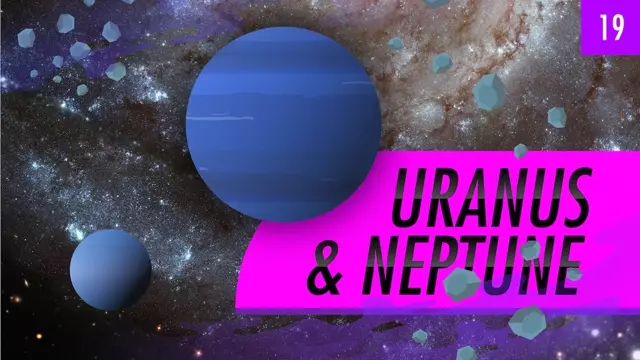2015-05-28
[public] 1.77M views, 23.9K likes, 563 dislikes audio only
Today we’re rounding out our planetary tour with ice giants Uranus and Neptune. Both have small rocky cores, thick mantles of ammonia, water, and methane, and atmospheres that make them look greenish and blue. Uranus has a truly weird rotation and relatively dull weather, while Neptune has clouds and storms whipped by tremendous winds. Both have rings and moons, with Neptune’s Triton probably being a captured iceball that has active geology.
This episode was brought to you by Squarespace http://www.squarespace.com/crashcourse
Check out the Crash Course Astronomy solar system poster here: http://store.dftba.com/products/crashcourse-astronomy-poster
--
Chapters:
Introduction: Uranus 00:00
Uranus's Structure 1:35
Uranus's Atmosphere 2:53
Uranus's Weird Tilt 3:55
Uranus's Moons 5:12
Uranus's Rings 6:00
Neptune's Structure 6:35
Neptune's Atmosphere 7:02
Neptune's Magnetic Field & Rings 8:10
Triton: Neptune's Largest Moon 8:36
The Discovery of Neptune 9:52
Review 11:27
--
PBS Digital Studios: http://youtube.com/pbsdigitalstudios
Follow Phil on Twitter: https://twitter.com/badastronomer
Crash Course is on Patreon! You can support us directly by signing up at http://www.patreon.com/crashcourse
Want to find Crash Course elsewhere on the internet?
Facebook - http://www.facebook.com/YouTubeCrashCourse
Twitter - http://www.twitter.com/TheCrashCourse
Instagram - https://www.instagram.com/thecrashcourse/
CC Kids: http://www.youtube.com/crashcoursekids
--
PHOTOS/VIDEOS
Uranus http://en.wikipedia.org/wiki/Voyager_2#/media/File:Uranus2.jpg [credit: NASA/JPL/Voyager mission]
Neptune https://www.nasa.gov/content/25-years-ago-voyager-2-captures-images-of-neptune/ [credit: NASA]
Uranus from Earth picture by Phil Plait
Uranus, Earth size comparison http://en.wikipedia.org/wiki/File:Uranus,_Earth_size_comparison.jpg [credit: NASA]
Uranus core, reconstructed from http://en.wikipedia.org/wiki/File:Uranus-intern-en.png [credit: Wikimedia Commons]
Uranus http://www.spacetelescope.org/static/archives/images/screen/opo0647b.jpg [credit: NASA, ESA, L. Sromovsky and P. Fry (University of Wisconsin), H. Hammel (Space Science Institute), and K. Rages (SETI Institute)]
Uranus storms http://www.keckobservatory.org/images/made/images/blog/Uranus_Aug20142_800_407.jpg [credit: Imke de Pater (UC–Berkeley)/Keck Observatory]
Uranus and rings (tilt demonstration) http://en.wikipedia.org/wiki/Uranus#/media/File:Uranusandrings.jpg [credit: Hubble Space Telescope - NASA Marshall Space Flight Center]
Uranus with rings and moons http://www.eso.org/public/images/eso0237a/ [credit: ESO]
Miranda http://en.wikipedia.org/wiki/Moons_of_Uranus#/media/File:Miranda.jpg [credit: NASA]
Verona Rupes http://apod.nasa.gov/apod/ap110404.html [credit: NASA]
Neptune’s Interior https://solarsystem.nasa.gov/multimedia/display.cfm?IM_ID=283 [credit: Lunar and Planetary Institute]
Neptune clouds http://en.wikipedia.org/wiki/File:Neptune_clouds.jpg [credit: NASA]
Neptune’s Great Dark Spot http://en.wikipedia.org/wiki/Neptune#/media/File:Neptune%27s_Great_Dark_Spot.jpg [credit: NASA / Jet Propulsion Lab]
Neptune’s Rings http://www.rolfolsenastrophotography.com/Astrophotography/Solar-System/i-vjMHSxz/A [credit: Rolf Wahl Olsen / NASA/JPL (Voyager 2, NASA Planetary Data System)]
Triton http://en.wikipedia.org/wiki/Triton_(moon)#/media/File:Triton_moon_mosaic_Voyager_2_(large).jpg [credit: NASA / Jet Propulsion Lab / U.S. Geological Survey]
Triton flipped http://en.wikipedia.org/wiki/File:PIA01538_Triton_flipped_v.jpg [credit: NASA/JPL]
Triton Nitrogen Geysers http://en.wikipedia.org/wiki/Triton_(moon)#/media/File:Voyager_2_Triton_14bg_r90ccw_colorized.jpg[credit: NASA]
http://www.patreon.com/crashcourse
http://www.patreon.com/crashcourse
/youtube/video/1hIwD17Crko?t=0
/youtube/video/1hIwD17Crko?t=95
/youtube/video/1hIwD17Crko?t=173
/youtube/video/1hIwD17Crko?t=235
/youtube/video/1hIwD17Crko?t=312
/youtube/video/1hIwD17Crko?t=360
/youtube/video/1hIwD17Crko?t=395
/youtube/video/1hIwD17Crko?t=422
/youtube/video/1hIwD17Crko?t=490
/youtube/video/1hIwD17Crko?t=516
/youtube/video/1hIwD17Crko?t=592

